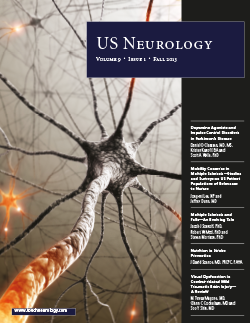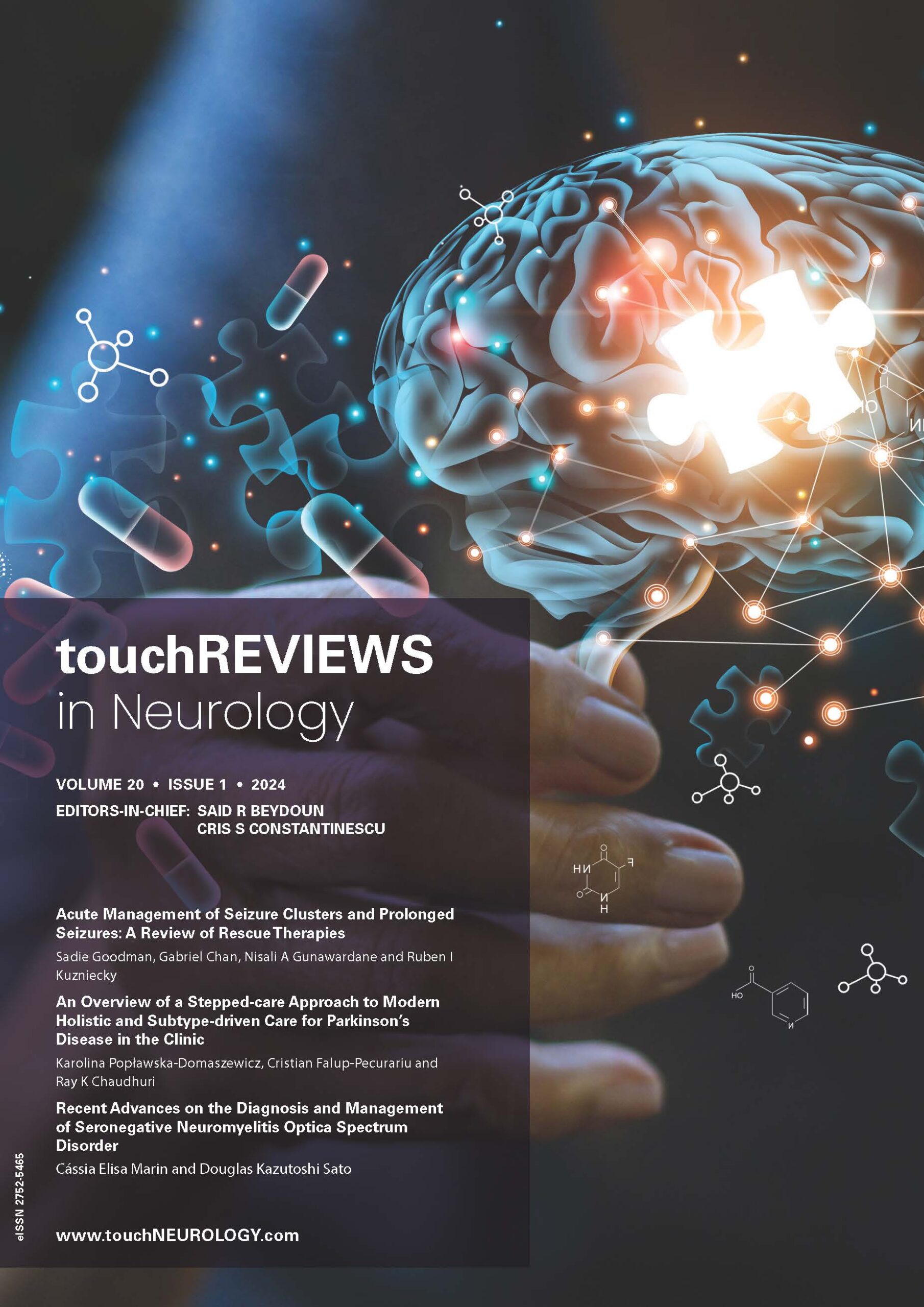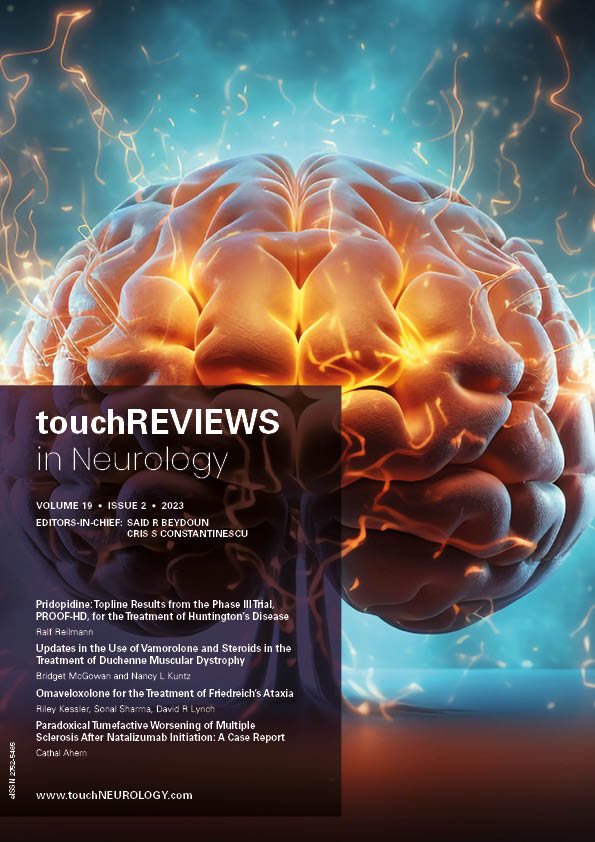US NEUROLOGY – VOLUME 9 ISSUE 1 – SPRING 2013
Welcome to the Fall edition of US Neurology. This edition features timely, expert review articles examining a range of pertinent topics. Multiple sclerosis (MS) provides a significant focus, with four articles exploring different aspects of this common and debilitating disorder. There is an emphasis on mobility issues, motor symptoms, falls and symptomatic treatment in MS. We also include articles on Parkinson’s disease, stroke, chronic inflammatory demyelinating polyneuropathy, autoimmune encephalitis and visual dysfunction in combat-related mild traumatic brain injury, all providing a worthy focus for our attention. Please peruse and enjoy the expert content and we welcome your feedback.
This edition of US Neurology covers a variety of themes important to practicing clinicians. Management matters involving multiple sclerosis (MS), stroke, Parkinson’s disease (PD), and brain trauma are emphasized. Maintaining mobility is a major goal in MS treatment. In the first article in this issue, mobility concerns of patients with MS relevant to nurses are […]
Movement Disorders
Parkinson disease (PD) is a devastating neurodegenerative disorder Characterized by its cardinal motor symptoms: resting tremor, muscular rigidity, bradykinesia, postural instability, and gait abnormality.1 PD currently affects 1–2 % of individuals over age 65, totaling five million people worldwide. During the next 20 years, the incidence of PD is projected to double, making research on […]
Dopamine Agonists for the Treatment of Parkinson’s Disease
Multiple Sclerosis
Multiple sclerosis (MS) is a chronic inflammatory-demyelinating disease caused by intermittent and recurrent episodes of multifocal inflammation in the central nervous system (CNS), which results in the demyelination and transection of axons in the brain, optic nerve, and spinal cord. This damage to the neuronal pathways affects signal conduction, causing neurologic disabilities, such as vision […]
Although disease modifying treatments (DMT) have been available for multiple sclerosis (MS) for many years, there is a continuous need to manage the variety of symptoms reported by the patients and to lessen the accumulation of impairments and disability that accompany disease progression. Symptomatic treatment, an important arm in the whole management of MS, is […]
Multiple sclerosis (MS) is a chronic, often disabling, neurologic disease, common among adults worldwide and in the US.1 It has a heterogeneous geographical prevalence with higher rates reported in Central and Northern Europe, North America, and Australia than for Asia, Africa, and South America.2 There are believed to be over 400,000 persons with MS in […]
Multiple sclerosis (MS) is an inflammatory demyelinating disease of the central nervous system, and is the leading cause of nontraumatic disability in young adults. Prevalence varies between 50 to 200 per 100,000 people.1–3 Despite recent therapeutic advances that have led to improvements in disease control in relapsing-remitting MS, the majority of individuals with MS experience […]
Stroke
Lacunar strokes (LACS), which result from occlusion of the deep penetrating arteries in the brain, are often milder than embolic or large vessel strokes.1 Even if they are mild in terms of stroke severity, it has been recognized that LACS often are associated with cognitive impairment.2 The cognitive profile may differ from that of primary […]
The importance of nutrition to stroke prevention is vastly under-appreciated. Many physicians and patients think that if they are taking a statin, they can eat whatever they want. Few concepts could be further from the truth. An analysis1 of the Nurses’ Health Study and the US Health Professionals study showed the importance of lifestyle in […]
Chronic Inflammatory Demyelinating Polyneuropathy
Chronic inflammatory demyelinating polyneuropathy (CIDP) is an acquired immune-mediated inflammatory disorder of the peripheral nervous system with an estimated prevalence of about 0.5 per 100,000 children and 1 to 2 per 100,000 adults.1,2 Typical CIDP arises between the ages of 30 and 60 years and is characterised from a progressive, symmetric proximal and distal muscle […]
Autoimmune Encephalitis
Autoantibody-mediated diseases of the central nervous system (CNS) are a rapidly expanding field within contemporary neuroimmunology. Autoimmune encephalitis (AIE) is a treatable cause of subacuteonset memory loss and confusion. In some patients, the evidence for inflammation is limited and the term autoimmune encephalopathy may be preferred. The associated spectrum of autoantibodies against specific molecules in […]
Brain Trauma
Traumatic brain injury (TBI) is the signature injury of the conflicts in Iraq and Afghanistan. The Department of Defense defines mild TBI by loss of consciousness for up to 30 minutes, or an alteration in mental state and/ or memory loss, which lasts less than 24 hours and structural brain imaging yielding normal results.1 Approximately […]

Trending Topic
Welcome to the latest edition of European Neurological Review, which features a wide range of articles of interest to neurologists and other practitioners involved in the care of patients with neurological illness. As we move into a new decade, the field of neurology continues to face fresh challenges. Despite an increased understanding of the pathophysiological […]
Journal Archive
touchREVIEWS in Neurology is a peer-reviewed, free-to-access, bi-annual neurology journal comprising review articles, case reports, practice guides, theoretical discussions, and original research. It features balanced and comprehensive articles written by leading authorities, addressing the most important and salient developments in the field of neurology.
Latest articles videos and clinical updates - straight to your inbox
Log into your Touch Account
Earn and track your CME credits on the go, save articles for later, and follow the latest congress coverage.
Register now for FREE Access
Register for free to hear about the latest expert-led education, peer-reviewed articles, conference highlights, and innovative CME activities.
Sign up with an Email
Or use a Social Account.
This Functionality is for
Members Only
Explore the latest in medical education and stay current in your field. Create a free account to track your learning.









